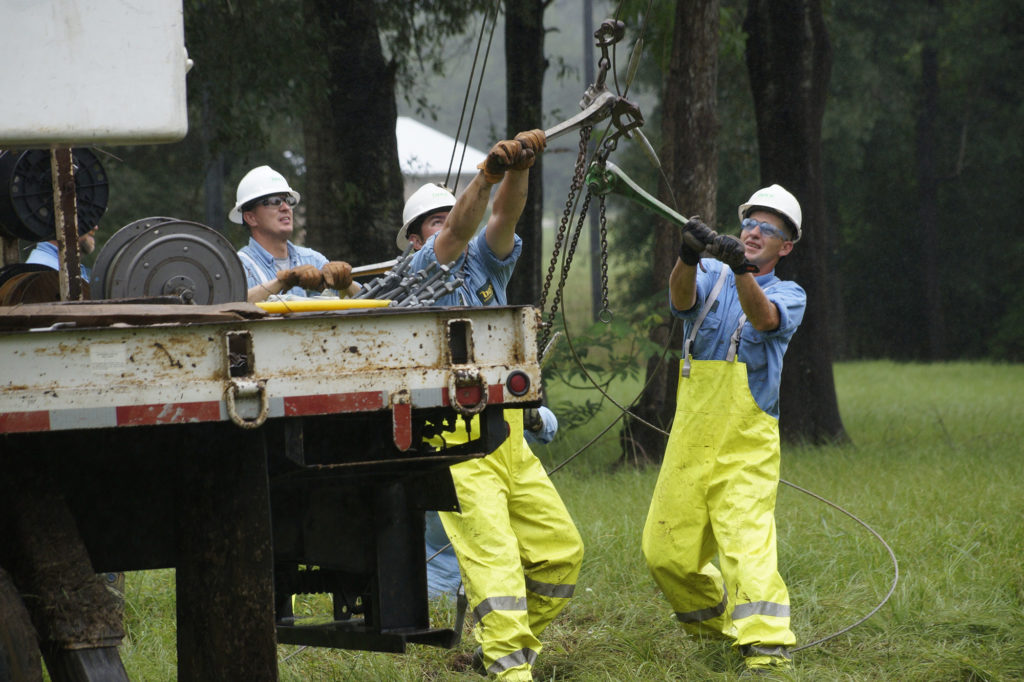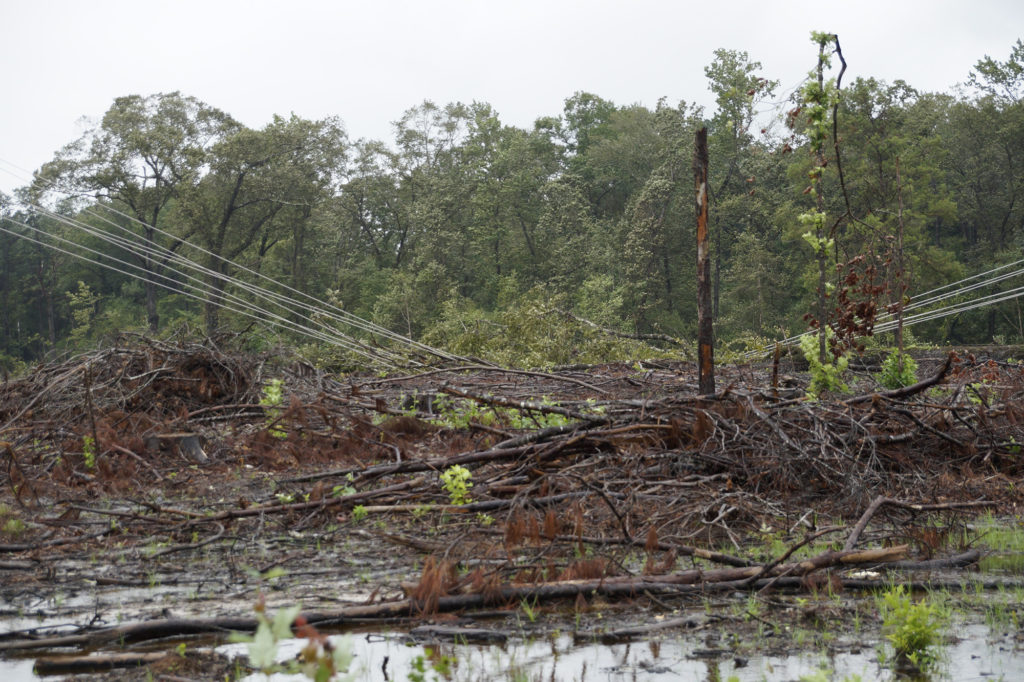
Tropical Storm Harvey has moved beyond south-central Texas, and although its winds were only gale force, moisture sucked up from the Gulf of Mexico means it is still a wet and destructive force.
Harvey’s second landfall Aug. 30 near Cameron, Louisiana, was in the service territory of Jefferson Davis Electric Cooperative. The storm caused scattered circuit outages; however crews quickly restored substations and are dealing with line problems caused by downed trees as they occur, according to officials from the Jennings, Louisiana-based co-op.
Deridder, Louisiana-based Beauregard Electric Cooperative reported about 3,000 meters out of service within hours of the storm’s approach. Though crews encountered high water in many locations, they brought back power to all but about 20 members by late morning Aug. 31.
“We had three major outages,” said Kay Fox, vice president of marketing and member services at Beauregard EC. “Most of the remaining damage to our system involves lines and poles submerged under water, so we can’t touch those until the water recedes.”
The Association of Louisiana Electric Cooperatives is coordinating intrastate mutual aid for its member co-ops. Beauregard EC is receiving mutual aid from South Louisiana Electric Cooperative Association, Houma, and Northeast Louisiana Power Cooperative, Winnsboro.
Claiborne Electric Cooperative in Homer has requested help from Baton Rouge-based Dixie Electric Membership Corp.
As the storm worked its way inland through central Louisiana, wet bands caused more problems for co-ops in the eastern part of Texas. The storm was expected to add another five to 10 inches of rainfall in some areas, although its 45 mph winds were only about one-third as strong as the sustained winds pushed out last week.
“We had about 5,000 members out, but more than 2,100 of those are connected to one substation,” said Joey Davis, director of member services for Jasper-Newton Electric Cooperative. “We have outages, system-wide, but primarily down near the Gulf or southern end.”
The co-op has been looking for a route to reactivate de-energized lines served by the substation, but high water was keeping crews from reaching some areas where repairs can be made, Davis said.
Co-ops in other parts of South Texas that suffered major storm-related outages over the past week are making substantial progress with restoration.
Victoria Electric Cooperative, which serves the Rockport, Texas, area, had 217 personnel in the field Aug. 30. They are working through outages affecting 22,000 meters that stopped spinning after Harvey’s initial landfall.
In a single day, “this amazing team helped bring over 8,000 meters online,” said Brittany Marsh, communications specialist for the Victoria, Texas-based co-op.
Crews made up of co-op staff, mutual aid workers from 10 other co-ops and contractors are working throughout the co-op’s service territory repairing damaged lines and replacing poles.
“Many of them have left their community, family and comforts of home to be here to help VEC get power to you as quickly as possible,” said Marsh. About 60 percent of the system was back up as of Aug. 31, though repairs could in some areas could take another week, the co-op said.
Mutual aid crews from three Texas co-ops are helping Jackson Electric Cooperative in Ganado, Texas, restore power to 500 members in an area that was previously under a mandatory evacuation.
Seven Texas co-ops are assisting Sinton, Texas-based San Patricio Electric Cooperative with a final push to bring 723 meters back on line as of midday Aug. 31.
Restoration work was nearly concluded for Guadalupe Valley Electric Cooperative, headquartered in Gonzales, Texas, which is getting power to all but two dozen of the 17,000 meters initially knocked out by the storm. “The old saying ‘stronger together’ has never been more evident than at this moment,” said General Manager and CEO Darren Schauer.
Wharton Electric Cooperative, based in El Campo, Texas, and La Grange, Texas-based Fayette Electric Cooperative are continuing touchup repairs as floodwaters subside. Both co-ops serve members in areas that have received more than 20 inches of rain over the past six days.
However, the storm has thrown Sam Houston Electric Cooperative in Livingston on to an outage roller coaster. The co-op had restored service to more than 21,000 meters since Harvey first made landfall as a Category 4 hurricane near Rockport, Texas on Aug. 25.
That didn’t hold.
“We had outages down to 800 [on Aug. 29] and now they’re back up to 5,000,” Keith Stapleton, chief communications officer, said Aug. 30. “Water and trees falling are the problem. The winds are moderate, but the ground is so saturated, it doesn’t take much for the trees to fall over. … We had a big tree fall right across from our office that took out a main feeder for about 20 minutes until we could get it cleared.”
With outage numbers rising, crews and contractors available to Sam Houston EC expect to be busy restoring power for several days—by nightfall Aug. 31, the outage number was just 1,700. But widespread flooding has inundated roads and made some areas inaccessible. Approximately 1,200 of the outages are inaccessible, and many are located in areas that have been evacuated.
“There are areas that are completely under water, and we can’t even see our poles and meters,” said Stapleton.

Flooding along Texas’ Trinity River prompted voluntary evacuations in three counties served by Sam Houston EC. And co-op managers continue to free up time for lineworkers, member services personnel and other staff to see to their homes and families.
“We have some employees who are in the flood zone. Water is getting into the homes of some of our employees as they work to restore power,” said Stapleton.
In some cases, the co-op could help find hotel space for the displaced families, while key field staff and inside support personnel are more likely to take their rest breaks at co-op facilities.
“There’s going to be some roads I won’t be able to get to for however long the flooding lasts,” said Rachel Frey, Sam Houston’s communications specialist. “I needed to get home and sort out arrangements for my dog and get clothes for the next few days.”
Experiences following past storms like Hurricane Rita in 2005 and Hurricane Ike, three years later, have provided useful lessons for planning and executing a prolonged response, Stapleton said.
“We have agreements with local church camps to house visiting crews,” Stapleton said. “We also have arrangements with companies that can provide tent cities for housing, food and support services for visiting crews should that be needed.”
Texas Electric Cooperatives, headquartered in Austin, is shipping poles and hardware to co-ops affected by Harvey. The statewide association is also compiling a list of charitable and community assistance organizations operating in the territories of the affected co-ops to provide storm relief to be shared with the cooperative community, officials said.
Derrill Holly is a staff writer at NRECA.
Editor’s note: This post is continually updated with the most recent outage reports.